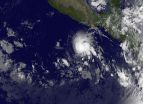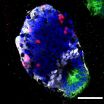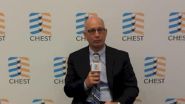(Press-News.org) Chicago, October 30, 2014—Analysis of data from an institutional patient registry on stereotactic body radiotherapy (SBRT) indicates excellent long-term, local control, 79 percent of tumors, for medically inoperable, early stage lung cancer patients treated with SBRT from 2003 to 2012, according to research presented today at the 2014 Chicago Multidisciplinary Symposium in Thoracic Oncology. The Symposium is sponsored by the American Society of Clinical Oncology (ASCO), the American Society for Radiation Oncology (ASTRO), the International Association for the Study of Lung Cancer (IASLC) and The University of Chicago Medicine.
The 300 patients in the study had 340 lesions (tumors) and were treated from October 1, 2003 through December 31, 2012, at the Cleveland Clinic, one of the early adopters of SBRT technology for lung cancer patients in the United States. Patients in the study had a median age of 74 years (range = 37-97 years), a median Karnofsky Performance Status (KPS) of 80 (range = 40-100), and were not candidates for surgery because of associated medical conditions, of which chronic obstructive pulmonary disease (COPD) was the most common (62 percent). Median follow-up was 17.4 months (range = 0.3-112.2 months), with 46.7 percent (140) patients alive at the time of follow-up. Median tumor diameter was 2.4 cm (range 0.1-10 cm), and 36.3 percent of tumors (123) had either no biopsy or a non-diagnostic biopsy. Fifteen percent of patients (45) received two or more SBRT treatments.
SBRT for lung cancer necessitates accurate and custom mapping of each individual patient's anatomy and a way of accounting for breathing motion to optimally target tumors while sparing as much of the surrounding healthy tissue as possible. In this study, all patients were uniformly treated using a vacuum-bag immobilization system and abdominal compression to limit breathing effects. Then, CT images were acquired to record tumor motion when at rest, full inhalation and full exhalation. These three images merged together generated the internal target volume (ITV) of the tumors, essentially representing a virtual map of tumor motion. Radiation doses were calculated to deliver ≥95 percent of the planning target volume (PTV), defined as the ITV + 5mm "safety" margin. All patients received 50 Gy in 5 fractions delivered during one week by 7-9 highly targeted radiation beams.
Early and late toxicity, as defined by the Common Terminology Criteria for Adverse Events (CTCAE) version 3.0 was measured for all patients. The overall rate of any toxicity was 13.0 percent (45), with most patients having minimal toxicities (grade 2 or less) and no grade 4 or 5 toxicity events were recorded. The most common occurrences were chest wall toxicity, 7.7 percent, and pneumonitis (inflammation of the lung tissue), 4.1 percent. The toxicity rate for the 115 lesions classified as "central" tumors, according to the RTOG 0813 definition of "within or touching the zone of the proximal bronchial tree or adjacent to mediastinal or pericardial pleura," vs. non-central tumors (225 lesions) was 15.5 percent (18 lesions) vs. 11.7 percent (27 lesions).
At five years post-treatment, local control was 79.0 percent vs. 75.4 percent for patients with central tumors vs. non-central tumors, respectively. The distant metastases-free and disease failure-free rates were 49.5 percent vs. 56.7 percent, and 37.3 percent vs. 34.3 percent, respectively. Overall survival was 18.3 percent vs. 20.3 percent, respectively. The failure rates of the central vs. non-central tumors utilizing all parameters had no statistically significant differences. Rates of local, lobar (within a whole lobe of the lung) and regional node failure for lesions were 11.2 percent, 4.1 percent and 13.5 percent, respectively.
"We have been privileged in demonstrating that lung SBRT can now be considered the standard of care for medically inoperable patients with early stage lung cancer," said Gregory M.M. Videtic, MD, lead study author, and a radiation oncologist at the Cleveland Clinic Foundation and associate professor of radiation oncology at the Cleveland Clinic Lerner College of Medicine, Case Western Reserve University. "Since our results indicate no unusual long term side effects, we are hoping to extend the potential uses of this therapy to more-fit, operable lung cancer patients whose cancer has not spread outside of the lung and to collaborate with other institutions on conducting such a clinical trial. SBRT could provide a more minimally invasive procedure than surgery, with fewer side effects and improved patient outcomes."
INFORMATION:
The abstract, "A Decade of "50 in 5": Maturing SBRT Outcomes for Medically Inoperable Early Stage Lung Cancer at Cleveland Clinic Over 10 Years," will be presented in detail during a poster session at 5:00 p.m. Central time on Thursday, October 30, 2014. To speak with Dr. Videtic, please call Michelle Kirkwood on October 30-October 31, 2014, in the Press Office at the Chicago Marriott Downtown Magnificent Mile at 312-595-3150, or email: michellek@astro.org.
The 2014 Chicago Multidisciplinary Symposium in Thoracic Oncology will provide a clinically relevant, multidisciplinary update on the scientific progress in treating thoracic malignancies. The symposium brings together physician specialists and practicing clinicians of the multidisciplinary care team to discuss the evolving management of thoracic cancers. The Symposium integrates scientific abstract presentations with accompanying discussions, poster abstract presentations, as well as "challenging case" presentations in interactive tumor board-style forums. The two keynote speakers for the Symposium are Kenneth Rosenzwieg, MD, FASTRO, of Mount Sinai School of Medicine in New York, and Corey J. Langer, MD, of Abramson Cancer Center in Philadelphia. Dr. Rosenzwieg will discuss the use of mutational analysis to guide systemic therapy; and Dr. Langer will review the cutting edge, lung cancer research presented at recent national meetings – ASCO, ASTRO and STS (Society of Thoracic Surgeons).
2014 Multidisciplinary Symposium in Thoracic Oncology
News Briefing, Friday, October 31, 2014, 7:00 a.m. Central time
Poster Presentation: Thursday, October 30, 2014, 5:00 p.m. Central time, Chicago Ballroom, Chicago Marriott Downtown Magnificent Mile
116 A Decade Of "50 In 5": Maturing SBRT Outcomes For Medically Inoperable Early Stage Lung Cancer At Cleveland Clinic Over 10 Years
Authors: G. M. Videtic, C. Reddy, N. Woody, T. Djemil, K. Stephans, Cleveland Clinic, Cleveland, OH
Purpose/Objective(s): To report on 10 years of experience with the first lung stereotactic body radiotherapy (SBRT) fractionation schedule used from the initiation of our institutional SBRT program.
Materials/Methods: We surveyed our IRB-approved prospective SBRT registry for all medically inoperable non-small cell lung cancer patients treated with 50 Gy in 5 fractions between 10/1/2003 and 12/31/2012. All patients were treated on a Novalis/BrainLAB platform using Bodyfix for immobilization and abdominal compression to limit tumor motion. Under compression, CT simulation images of tumor acquired at rest, full inhalation, and full exhalation were merged to generate an internal target volume (ITV). Dose was prescribed to cover > 95% of the planning target volume (PTV) defined as PTV=ITV + 5 mm margin. SBRT was planned using heterogeneity corrections and delivered by 7-9 IMRT beams over consecutive days with daily Exactrac for IGRT.
Results: Three hundred forty lesions were treated in 300 patients, of which 15% had multiple treatments. Median follow up for survival was 17.4 months (range 0.3-112.2) and 17.8 months for living patients (range 2.1-96.7) with 46.7% of patients alive at analysis. Median age was 74 years (range 37-97); median KPS was 80 (range 40-100); 56% were female. Median FEV1 and DLCO (as % predicted) were 59 and 52. The principal co-morbidity for medical inoperability was pulmonary in 62.0% of patients, with 18.3% smoking at SBRT. Median tumor diameter was 2.4 cm (range 0.1-10); median PET SUV max was 7.6 (range 1-59); 36.2% of tumors had no or non-diagnostic biopsies. Per RTOG 0813 definition, 115 lesions (33.8%) were "central". Overall, the rate of any grade toxicity was 13.0 % (with no grades 4 or 5) and chest wall symptoms constituted 7.7%. For central versus non-central lesions, the toxicity rate was 15.5% vs. 11.7%, with chest wall toxicity constituting 5.8% vs. 8.6% and pneumonitis 5.8% vs. 3.0%, respectively. For central versus non-central lesions, five-year actuarial local control, distant metastases-free, disease failure-free, and overall survivals (in %) were 79.0 v 75.4, 49.5 v 56.7, 37.2 v 34.3, and 18.3 v 20.3, respectively. At analysis, crude rates by lesion of local, lobar and regional nodal failure (in %) were 11.2, 4.1 and 13.5, respectively. There were no statistically significant differences in the failure rates between central and non-central lesions for all parameters.
Conclusions: A decade's experience with Lung SBRT using 50 Gy in 5 fractions reveals excellent local control. Patterns of cancer failure are mainly distant. Co-morbidities drive mortality in this population. This schedule is effective independent of tumor location in the lung, with minimal toxicities that are location-dependent.
Disclosures: G.M. Videtic: None. C. Reddy: None. N. Woody: None. T. Djemil: None. K. Stephans: None.
Sustained local control for medically inoperable, early stage lung cancer patients
Analysis of 10 years of data for patients who received high-dose rate stereotactic body radiotherapy
2014-10-30
ELSE PRESS RELEASES FROM THIS DATE:
What do American babies eat? A lot depends on Mom's socioeconomic background
2014-10-30
BUFFALO, N.Y. – You have to be at least 2 years old to be covered by U.S. dietary guidelines. For younger babies, no official U.S. guidance exists other than the general recommendation by national and international organizations that mothers exclusively breastfeed for at least the first six months.
So what do American babies eat?
That's the question that motivated researchers at the University at Buffalo School of Medicine and Biomedical Sciences to study the eating patterns of American infants at 6 months and 12 months old, critical ages for the development of ...
Twenty-first Eastern Pacific tropical depression born on Oct. 30
2014-10-30
NOAA's GOES-West satellite captured an image of the birth of the Eastern Pacific Ocean's twenty-first tropical depression, located far south of Acapulco, Mexico.
NOAA's GOES-West satellite gathered infrared data on newborn Tropical Depression 21E (TD 21E) and that data was made into an image by NASA/NOAA's GOES Project at NASA's Goddard Space Flight Center in Greenbelt, Maryland. At 1200 UTC (9 a.m. EDT), the GOES-West image showed that thunderstorms circled the low-level center and extended northeast of the center indicating that southwesterly wind shear was affecting ...
Reconstruction of a patterned piece of spinal cord in 3-D culture
2014-10-30
Professor Elly Tanaka and her research group at the DFG Research Center for Regenerative Therapies Dresden - Cluster of Excellence at the TU Dresden (CRTD) demonstrated for the first time the in vitro growth of a piece of spinal cord in three dimensions from mouse embryonic stem cells. Correct spatial organization of motor neurons, interneurons and dorsal interneurons along the dorsal/ventral axis was observed.
This study has been published online by the American journal "Stem Cell Reports" on 30.10.2014.
For many years Elly Tanaka and her research group have been studying ...
Harnessing error-prone chips
2014-10-30
As transistors get smaller, they also grow less reliable. Increasing their operating voltage can help, but that means a corresponding increase in power consumption.
With information technology consuming a steadily growing fraction of the world's energy supplies, some researchers and hardware manufacturers are exploring the possibility of simply letting chips botch the occasional computation. In many popular applications — video rendering, for instance — users probably wouldn't notice the difference, and it could significantly improve energy efficiency.
At ...
Female frogs modify offspring development depending on reproduction date
2014-10-30
Global warming is altering the reproduction of plants and animals, notably accelerating the date when reproduction and other life processes occur. A study by the University of Uppsala (Sweden), including the participation of Spanish researcher Germán Orizaola, has discovered that some amphibians are capable of making their offspring grow at a faster rate if they have been born later due to the climate.
Over recent decades many organisms, both plants and animals, have experienced a notable advance in the date when many of their life processes (like reproduction, migration ...
Could daylight savings time be a risk to diabetics?
2014-10-30
Soon, many will turn back the hands of time as part of the twice-annual ritual of daylight savings time. That means remembering to change the alarm clock next to the bed, which will mean an extra hour of sleep before getting up in the morning.
But for some diabetics who use insulin pumps, Saleh Aldasouqi, associate professor of medicine at Michigan State University, suggests that remembering to change the time on this device should be the priority.
"Some diabetes patients who use insulin pumps may forget to change the clock that is found in these devices," said diabetes ...
Is space tourism safe or do civilians risk health effects?
2014-10-30
Rochelle, NY, October 30, 2014—Several companies are developing spacecraft designed to take ordinary citizens, not astronauts, on short trips into space. "Space tourism" and short periods of weightlessness appear to be safe for most individuals according to a series of articles on space biomedicine published in New Space, a peer-reviewed journal from Mary Ann Liebert, Inc., publishers. The articles are available free on the New Space website until November 30, 2014.
James Vanderploeg, MD, MPH and colleagues, University of Texas Medical Branch, Galveston, coauthored ...
NASA sees Cyclone Nilofar looking more like a comet than a tropical cyclone
2014-10-30
Tropical Cyclone Nilofar was closing in on the border between Pakistan and northwestern India on Oct. 30 when NASA's Terra satellite passed overhead from space. Wind shear continued to affect the storm making it appear more like a comet with a tail, than a tropical cyclone.
The MODIS or Moderate Resolution Imaging Spectroradiometer instrument that flies aboard NASA's Terra satellite captured a visible image of Nilofar on Oct. 30 at 06:35 UTC (2:35 a.m. EDT). Nilofar was still being affected by southwesterly wind shear, which was blowing the clouds and showers to the northeast. ...
CHEST lung cancer experts present policy statement to CMS Committee on Coverage
2014-10-30
VIDEO:
Dr. Gerard Silvestri gives background on lung cancer screening recommendations.
Click here for more information.
October 30, 2014, Glenview, Illinois -- As the Centers for Medicare & Medicaid Services (CMS) Committee on Coverage studies the decision to cover lung cancer screening for eligible individuals, today's Online First section of the journal CHEST published Components for High Quality Lung Cancer Screening: American College of Chest Physicians and American Thoracic ...
Clinical practice guidelines address multimodality treatment for esophageal cancer
2014-10-30
Chicago, October 30, 2014 – The Society of Thoracic Surgeons (STS) has released new clinical practice guidelines for treating cancer of the esophagus and gastroesophageal junction (area where the esophagus meets the stomach).
The guidelines, published in the November 2014 issue of The Annals of Thoracic Surgery, include nine evidence-based recommendations that address issues related to multimodality care, including neoadjuvant therapy (chemotherapy and radiation therapy given prior to surgery). The goal of this therapy is to reduce the extent of cancer before an ...
LAST 30 PRESS RELEASES:
Personalised “cocktails” of antibiotics, probiotics and prebiotics hold great promise in treating a common form of irritable bowel syndrome, pilot study finds
Experts developing immune-enhancing therapies to target tuberculosis
Making transfusion-transmitted malaria in Europe a thing of the past
Experts developing way to harness Nobel Prize winning CRISPR technology to deal with antimicrobial resistance (AMR)
CRISPR is promising to tackle antimicrobial resistance, but remember bacteria can fight back
Ancient Maya blessed their ballcourts
Curran named Fellow of SAE, ASME
Computer scientists unveil novel attacks on cybersecurity
Florida International University graduate student selected for inaugural IDEA2 public policy fellowship
Gene linked to epilepsy, autism decoded in new study
OHSU study finds big jump in addiction treatment at community health clinics
Location, location, location
Getting dynamic information from static snapshots
Food insecurity is significant among inhabitants of the region affected by the Belo Monte dam in Brazil
The Society of Thoracic Surgeons launches new valve surgery risk calculators
Component of keto diet plus immunotherapy may reduce prostate cancer
New circuit boards can be repeatedly recycled
Blood test finds knee osteoarthritis up to eight years before it appears on x-rays
April research news from the Ecological Society of America
Antimicrobial resistance crisis: “Antibiotics are not magic bullets”
Florida dolphin found with highly pathogenic avian flu: Report
Barcodes expand range of high-resolution sensor
DOE Under Secretary for Science and Innovation visits Jefferson Lab
Research expo highlights student and faculty creativity
Imaging technique shows new details of peptide structures
MD Anderson and RUSH unveil RUSH MD Anderson Cancer Center
Tomography-based digital twins of Nd-Fe-b magnets
People with rare longevity mutation may also be protected from cardiovascular disease
Mobile device location data is already used by private companies, so why not for studying human-wildlife interactions, scientists ask
Test reveals mice think like babies
[Press-News.org] Sustained local control for medically inoperable, early stage lung cancer patientsAnalysis of 10 years of data for patients who received high-dose rate stereotactic body radiotherapy







